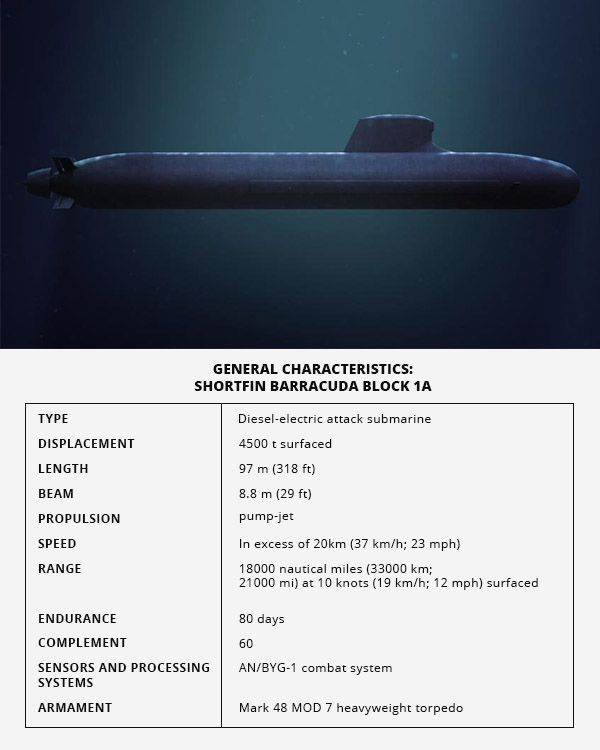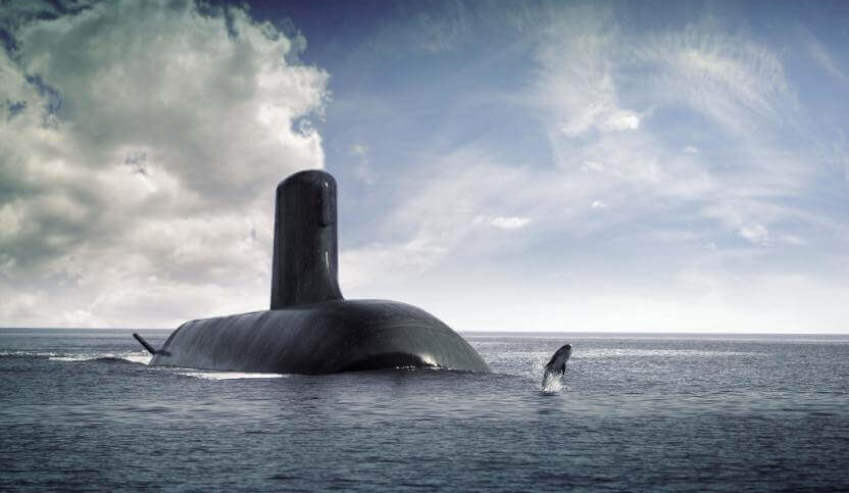It is the largest defence acquisition project in the history of the nation, but the $50 billion, or is it $80 billion, project to replace the ageing Collins Class submarines with 12 regionally-superior submarines is in deep water as growing concerns about cost, capability and delivery time frame begin to sow confusion.
To continue reading the rest of this article, please log in.
Create free account to get unlimited news articles and more!
When then prime minister Malcolm Turnbull announced the DCNS, now Naval Group, Shortfin Barracuda as the successful design for the hotly contested SEA 1000 Future Submarine program in April 2016, it seemed as if the disastrous procurement of the Collins Class would be put aside.
As the prime minister assured both defence and the Australian public: "The Competitive Evaluation Process (CEP) has provided the government with the detailed information required to select DCNS as the most suitable international partner to develop a regionally-superior future submarine to meet our unique national security requirements."
The successful Shortfin Barracuda design is a conventionally powered variant of the nuclear powered Barracuda fast attack submarine currently under construction in France for the French Navy.
It is expected to deliver a quantum leap in the capability delivered to the Royal Australian Navy and its submarine service by leveraging technology and capabilities developed for nuclear submarines but implemented on a conventional submarine.
But now, more than two years after the initial announcement, contracting tensions between Naval Group and the Commonwealth are rising – and there is growing public and parliamentary concern regarding the cost of the mega-project.
Concerns about the performance and apparent design changes for some of the key technologies, including the pump-jet propulsion system and battery system, are also mounting. Moreover, a number of parliamentary and strategic policy leaders are expressing concerns over potential capability gaps caused by over runs to the delivery time.
Subs, but not at any cost...
South Australian senator Rex Patrick has been a prominent advocate for South Australian shipbuilding, particularly regarding SEA 1000 local content and workforce contribution, but as he recently told Defence Connect, new concerns are brewing around cost and contracting of the strategic project.
"With the project having gone from $50 billion to $200 billion and Australian content plummeting from 90 per cent to 50 per cent (maybe), and the build work on the Shortfin Barracuda not commencing until at least 2024, it would be irresponsible not to reassess the situation.
"Additionally, if we are having trouble with our strategic industry partner (Naval Group) in the contracting phase, it doesn't bode well for the future of the program," he said.
These concerns are just the tip of the iceberg for Senator Patrick, with him describing growing concerns around proposed changes to design.
These include the removal of the air-independent propulsion (AIP) system plus the inclusion of lead-acid battery systems as opposed to the modern lithium-ion batteries installed upon contemporary submarines like the Japanese Soryu Class, German Type 212 and 214 classes, and Naval Group's own Scorpene Class currently in service with Brazil and India.
"As a former submariner, I am pro-submarine, I understand the strategic and tactical advantages these platforms provide us, but submarines at any price? No." Senator Patrick said.
"We have to ask: with the regional strategic situation changing since the original plan was announced in 2009, why would we be considering old technology, like lead-acid batteries for example, in what is supposed to be a regionally-superior submarine?"
It is important to note that Senator Patrick is not advocating for the cancellation of the key naval shipbuilding project however.
"The reality is that for less than $20 billion Australia could have up to 20 highly capable near off-the-shelf submarines, built in South Australia, with the build commencing two years sooner and modified and enhanced by Australian industry. Imagine what Defence could with more than $100 billion to spend on other capability."
Performance concerns grow
These technological and capability concerns were echoed by physicist Aidan Morrison who, in an extensive report developed and considered by Defence, highlighted key concerns regarding the performance of the pump-jet propulsion systems to be installed in the new submarines.
"I find that the arguments put forward by Defence are so completely inept and irreconcilable with known facts that it is generally implausible that they represent the "best possible advice" that Defence is able to produce.
"The degree of incompetence and ignorance required for such views to be maintained during six years of research and analysis since the pump-jet's suitability was first challenged in Parliament in 2012 – including after France provided propulsive performance data during the CEP – is frankly beyond belief," Morrison said.
In response, Defence reinforced its commitment to pump-jet propulsion, saying the design specifics of the future submarine was progressing according to plan, with all agreed upon technologies' key components included.
"The predicted performance of a submarine pump-jet needs to be assessed with regard for the hydrodynamic performance of the submerged submarine, having considered how the design of the pump-jet has been matched to the hull design to optimise the overall performance of the submarine for its intended roles," a Defence report states – highlighting concerns regarding the performance and capacity of the systems to meet the unique operating requirements presented by Australia's operational environment, namely distance, current and ocean depth.
"Its size remains appropriate to the inclusion of a pump-jet that can be designed to optimise the performance of the submarine for its intended roles.
"Similar considerations apply to decisions about other technologies for the Future Submarine, including battery and other propulsion technologies," Defence said.
Additionally, Defence maintains that decisions on these technologies would be informed by their intended applications when considered against proposed submarine missions, along with assessments of technical risk impacting cost, schedule and performance.
Strategic realities require a rethink?
Now enter the growing capability gap concerns presented by an increasing number of Australia's leading strategic policy thinkers.
Dr Malcolm Davis of the Australian Strategic Policy Institute has highlighted mounting concerns over the apparent capability gap presented by the delayed future submarine program and the declining capability of the existing Collins Class to Defence Connect.
"One of our key capability gaps is effective long-range strike; we need to develop that capability quickly, especially as the future submarines continue to face delay. This means we need to work with the United States on developing a potent, air-based long-range strike capability for Australia," he said.
Dr Davis further expanded on concerns over the changing strategic environment raised by Senator Patrick, particularly growing distress about the rapidly shrinking 'Sea/Air Gap' of Australia's northern approaches, which has long been considered a defensive 'moat' that would provide the nation adequate time to plan and respond to any contingency.
"We do need to think about more sharing of the regional strategic burden with the United States. Especially in the face of an assertive China, not only in the South China Sea, but also in the Indian Ocean and south Pacific. Simply put: the 'Sea/Air Gap is the moat that no longer exists," he said.
Reinforcing this, Associate Secretary at the Department of Defence Brendan Sargeant in a recent speech at ANU, titled 'A Radical New Defence Policy', highlighted the operational and strategic importance of getting the future submarine project and capability correct.
"Emerging capabilities such as the Joint Strike Fighter, the Future Frigate and the Future Submarine will change our strategic environment, increase Australia’s military power and will create new opportunities for engagement and capability building in the Indo-Pacific," he said.
Pyne's counter-punch
In response to the concerns rides the champion of Australia's defence industry, Defence Minister Christopher Pyne, to reassure and strongly refute the claims and issues raised regarding capability concerns and gaps, contracting dilemmas and cost overruns.
Recently, Minister Pyne discussed the status of the SEA 1000 Future Submarines project at great length with Andrew Bolt of the Bolt Report.
Primarily, Minister Pyne was concerned with correcting the record on price, stating that "the envelope of money has not changed for the 12 submarines. It's a $50 billion project. It was at the beginning, and it still is now".
When pushed regarding claims about the added cost of the submarines' AN/BYG-1 weapons systems and the ongoing design and mobilisation contract, a key component of the strategic partnership between the Commonwealth and Naval Group, Minister Pyne was clear.
"Yes, they [combat systems] are [included in the $50 billion]. So, the contract that’s currently running the submarine project is the design and mobilisation contract; that’s exactly as it’s supposed to be.
"So, literally, it’s designing the shipyard, designing the submarine, mobilising the workforce, Australians at Cherbourg learning about how the Naval Group design a submarine so they can do it themselves in Australia.
"Everything that needs to be done is being done. The SPA – the Strategic Partnering Agreement – is the 30, 40-year long contract that needs to be signed. But certainly, there has been no ending of works or delay in the project at all."
Regarding the issues surrounding pump-jet propulsion and other design components, Minister Pyne explained: "Jean-Michel [Billig Naval Group executive director, SEA 1000] was new to Australia and new to that job and I don't think he was necessarily well briefed."
"The decision that the government made is a propulsion system, a jet propulsion system. That was the offering by Naval Group in the competitive evaluation process. That has never changed and there's no suggestion that it will be altered."
Minister Pyne remained resolute in defending the capability to be delivered by the Shortfin Barracuda, despite concerns about the long lead time to deliver the submarines, with all 12 expected to be in operation by the mid-2050s.
The minister went on to explain that the submarines, as with their global counterparts, will evolve throughout the construction cycle.
"The first submarine will be based on the most up-to-date technology when it goes into the water. The last submarine is obviously not going to be exactly the same as the first submarine. It will be based on the most up-to-date technology by the time it goes into the water," he said.
Despite the best efforts, it appears as if the Future Submarine program is going to face a number of ongoing challenges prior to their introduction into service.
Let us know your thoughts in the comments below.

 Login
Login







